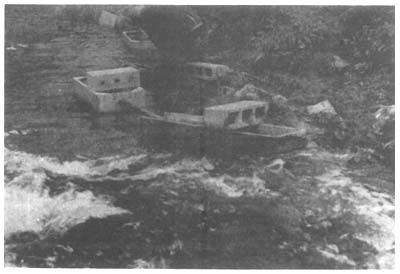by
D.P. O'Leary
Regional Civil Engineer, Electricity Supply Board
Ardnacrusha, Limerick, Ireland
The Electricity Supply Board are the owners of the entire Eel Fishery on the River Shannon. The catchment area of the Shannon is 1 049 600 hectares and the water surface area of the main lakes and rivers is 35 000 hectares.
During a visit to Ireland in 1966 Mr. Koops of the Fishery Institute Hamburg recommended that the Shannon should be stocked with 20 million to 30 million elvers per year. At that time uncounted elvers passed into the Shannon lakes through elver passes at Ardnacrusha and Parteen Weir. We then decided to trap these elvers and count and transport them to the lakes. We always considered that the natural run was around 10 million but trapping and counting revealed that the run was only 5 million. We were then faced with the problem of finding and transporting the remainder from other sources. There is no system of organised elver catching in Ireland.
Owing to the high rainfall and low river grades in Ireland land suffers considerable flooding. To relieve this situation the Government passed the 1945 Arterial Drainage Act. All the smaller flour mills built in the 1840's became derelict in the 1930's. Consequently as drainage schemes proceeded most Weirs were removed and river gradients flattened. This has made the catching of elvers almost impossible due to the lack of obstructions. Once a drainage scheme is completed it is illegal to put an obstruction in a river without the permission of the Drainage Authority. Such permission is not easily obtained.
These circumstances prevailed in the River Feale which has an elver run of up to 15 million and has no lake system and is consequently unsuitable for the production of eels. The necessity for an elver trap which would operate under a head of 5 cm was obvious. Many ideas were tried until ultimately the design shown in Figure 4 was arrived at.
This type of trap has many advantages:
The trap essentially consists of a nylon brush which comes to and abrupt and at an inclined groove which is cut across the timber on which the brushwork is mounted. Water enters the upstream and of the trap through an adjustable slot and runs over a smooth timber surface. The velocity over this surface is such that elvers cannot proceed. Longitudinal guides help to distribute the water and makes mounting of the trap less critical.
After travelling over the smooth surface the water enters the groove where part of the water flows along the groove and into the pipe. The remainder of the water flows down through the brushwork.
Elvers travelling close to the bank will enter the water flowing out through the brushwork and travel up to the groove where they get into the high velocity stream of water in the groove and are washed into the pipe and down into the holding tank.
We have found from experience that it is an advantage to have approx. 10 cm of smooth board at the downstream and of the brushwork. By moving stones around in the river bed it is possible to make the velocity on the river side of the trap too fast for elvers and thus make them enter the brush. The space between the trap and the bank must be filled with stiff blue clay.
Traps are best made with left and right hand outlets as the smooth side can then be put next to a bridge pier.
Figures 1–3 show one of these traps mounted at a rapid in a small river.
The bristles stand 88 mm over the base and consist of tufts of 120 bristles of 0.3 mm green nylon. The tufts are at 10 mm centres in staggered rows.
The base is made of hardwood (Iroko) and is tapered from 45 mm at the upstream and to 15 mm at the downstream end.
The tufts of nylon are fixed to the base by lacing with stainless steel wire.
The sides project 120 mm above the base. This will enable the sides to be loaded with weights to provide stability without damaging the brushwork.
The groove is 40 mm wide and 20 mm deep and inclined at an angle of 50°.
The water inlet slot has a maximum opening of 15 mm.
The width of the brushwork is 300 mm. It is hoped to construct brushwork up to 600 mm before the next elver fishing season.
The overall length will vary with the river gradient. Our present length is approximately 1.35 m for very low river gradients. This can be reduced to 0.8 m where the river gradient is steep.
Working details are shown in the attached Figure 4.
It is hoped to add a very faint light to the downstream and of some of these traps next season.
DISCUSSION: No discussion

Fig. 1 Elver trap positioned at water edge along river bank

Fig. 2 Trap detail: showing position and bristles

Fig. 3 Trap detail: showing inlet and slot

Fig. 4 Elver trap